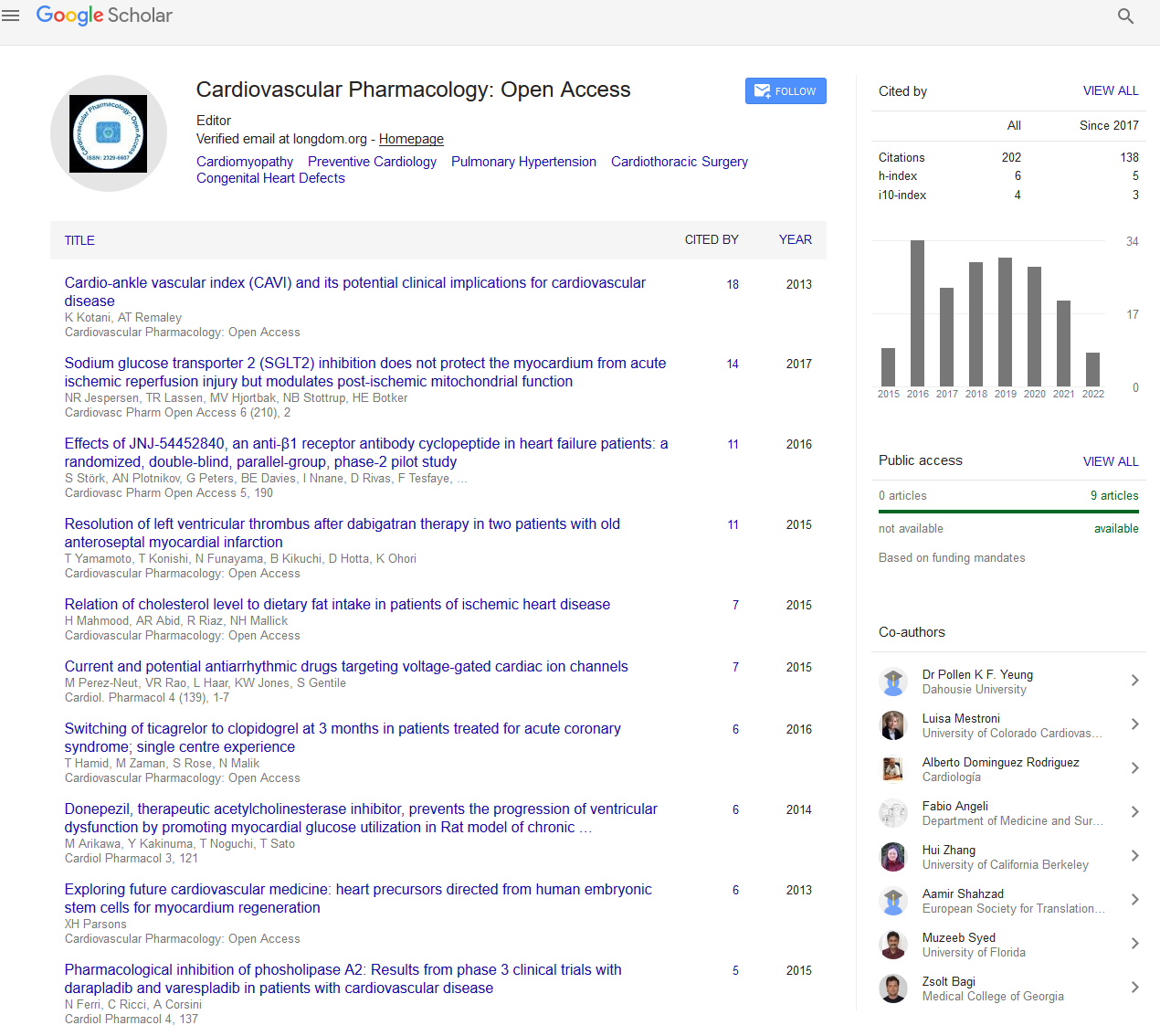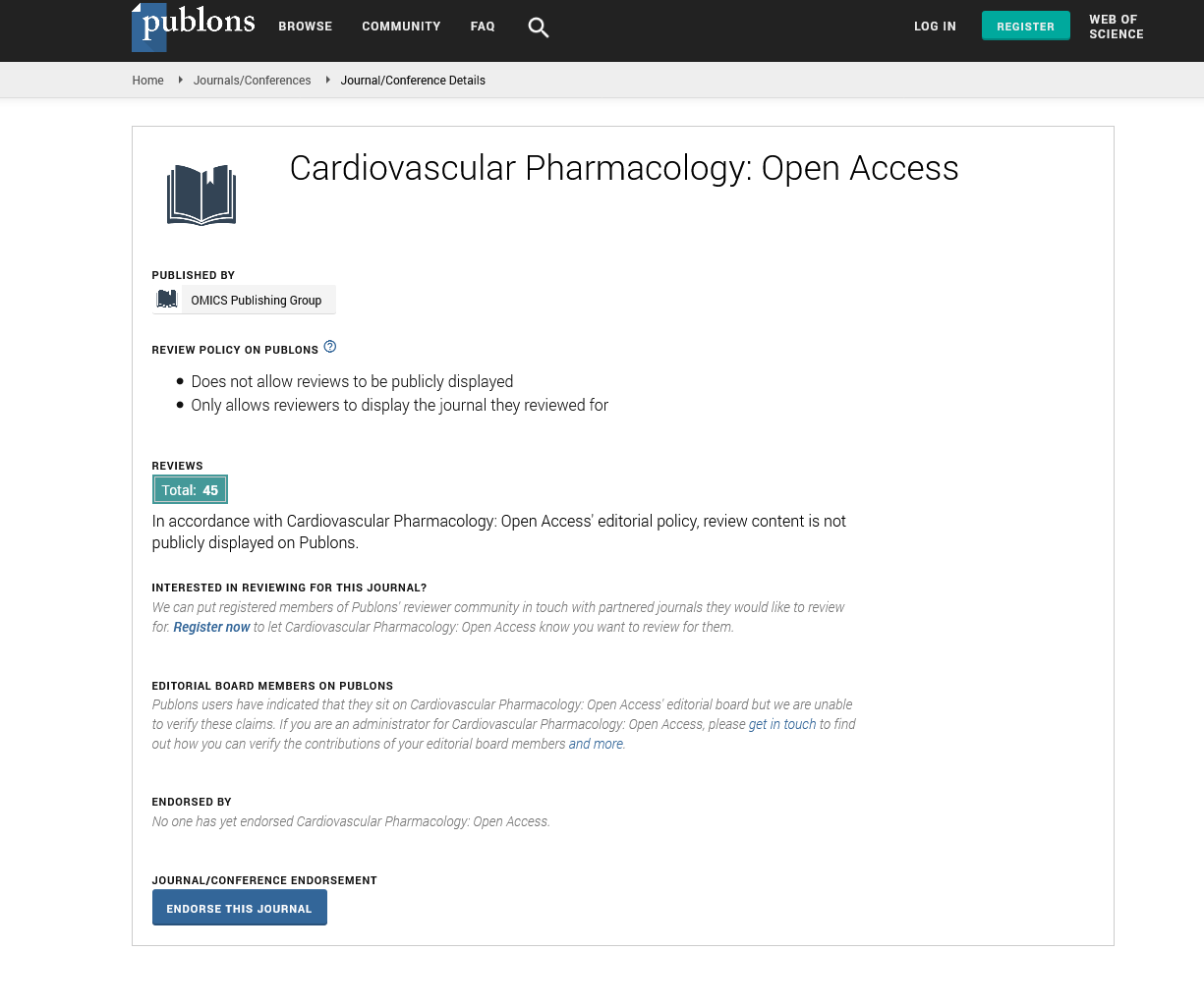Indexed In
- Open J Gate
- Cosmos IF
- RefSeek
- Hamdard University
- EBSCO A-Z
- OCLC- WorldCat
- Publons
- Geneva Foundation for Medical Education and Research
- Euro Pub
- Google Scholar
Useful Links
Share This Page
Journal Flyer

Open Access Journals
- Agri and Aquaculture
- Biochemistry
- Bioinformatics & Systems Biology
- Business & Management
- Chemistry
- Clinical Sciences
- Engineering
- Food & Nutrition
- General Science
- Genetics & Molecular Biology
- Immunology & Microbiology
- Medical Sciences
- Neuroscience & Psychology
- Nursing & Health Care
- Pharmaceutical Sciences
Perspective - (2025) Volume 14, Issue 1
Targeting MFAP4 for Advancing Retinal Neovascular Disease Therapies
Hiroshi Yamamoto*Received: 19-Feb-2025, Manuscript No. CPO-25-28927; Editor assigned: 21-Feb-2025, Pre QC No. CPO-25-28927 (PQ); Reviewed: 07-Mar-2025, QC No. CPO-25-28927; Revised: 14-Mar-2025, Manuscript No. CPO-25-28927 (R); Published: 21-Mar-2025, DOI: 10.35248/2329-6607.25.14.417
Description
Retinal neovascularization and vascular leakage are hallmark features of several blinding ocular diseases, including Diabetic Retinopathy (DR), Age-related Macular Degeneration (AMD) and Retinopathy of Prematurity (ROP). The prevailing treatment strategies, particularly anti-VEGF agents, have significantly improved clinical outcomes; however, limitations such as partial responsiveness, recurrence, high treatment burden and off-target effects necessitate the exploration of novel targets. Recent research has highlighted Microfibrillar-Associated Protein 4 (MFAP4) as a critical regulator of extracellular matrix remodeling and vascular pathology, opening new therapeutic avenues in retinal disease.
MFAP4 is an extracellular matrix glycoprotein primarily associated with elastic fibers and integrin signaling. It plays a role in vascular remodeling, inflammation and smooth muscle cell migration. Elevated expression of MFAP4 has been implicated in pathological angiogenesis in various tissues, including the retina. In experimental models, increased MFAP4 expression correlates with upregulated pro-angiogenic signaling, enhanced endothelial cell proliferation and exacerbated vascular permeability. These findings suggest that MFAP4 is not merely a bystander in retinal pathology but an active driver of disease progression.
Pharmacological inhibition of MFAP4 has shown promising results in preclinical models of ocular neovascularization. In mouse models of oxygen-induced retinopathy, systemic or intraocular administration of MFAP4-blocking antibodies resulted in a marked reduction in abnormal vessel formation, decreased vascular leakage and improved retinal architecture. These effects appear to be mediated through downregulation of integrin-mediated signaling pathways, suppression of endothelial cell activation and modulation of local inflammatory responses. Importantly, MFAP4 inhibition did not significantly affect normal vascular structures, indicating a potential therapeutic window that spares physiological angiogenesis.
From a therapeutic perspective, targeting MFAP4 may complement or even enhance existing anti-VEGF strategies. While VEGF plays a central role in angiogenesis, it is not the only factor contributing to retinal vascular pathology. Some patients with DR or AMD exhibit limited response to anti-VEGF agents, possibly due to VEGF-independent pathways of angiogenesis and leakage. MFAP4 may serve as a parallel or upstream modulator and its blockade could suppress these alternative mechanisms. Combination therapies involving anti-VEGF and anti-MFAP4 agents might offer synergistic benefits by addressing multiple facets of the disease process.
Another advantage of MFAP4-targeted therapy lies in its broader implications for fibrosis and chronic inflammation, which are common sequelae in advanced retinal diseases. MFAP4 has been implicated in tissue remodeling and fibrotic responses and its inhibition may reduce the progression of fibrovascular membranes and macular scarring, thereby preserving vision in the long term. This multifaceted benefit could significantly improve the durability and effectiveness of treatment regimens.
However, several challenges remain before MFAP4 inhibitors can be translated into clinical practice. Firstly, the pharmacokinetics and long-term safety profile of anti-MFAP4 agents must be established. Given its expression in multiple tissues, systemic inhibition could carry off-target effects unless localized delivery strategies such as intravitreal injections or targeted nanocarriers are optimized. Secondly, the identification of patient subgroups most likely to benefit from MFAP4 inhibition will be critical for personalized therapy. Biomarker development to detect elevated MFAP4 expression in ocular fluids or tissues could guide treatment decisions.
Moreover, rigorous clinical trials will be essential to determine efficacy, optimal dosing and combination strategies with existing therapies. While preclinical data are encouraging, they must be validated in the context of human disease heterogeneity and comorbid conditions. Regulatory frameworks and cost-effectiveness analyses will also influence the adoption of MFAP4-targeted agents into standard ophthalmic care.
In conclusion, the pharmacological blockade of MFAP4 represents a promising new direction in the management of retinal neovascular diseases. By modulating extracellular matrix interactions and angiogenic signaling beyond VEGF, MFAP4 inhibition could offer enhanced disease control, reduced treatment burden and better visual outcomes. As our understanding of retinal pathophysiology evolves, expanding the therapeutic toolkit to include targets like MFAP4 reflects a necessary shift toward precision medicine and long-term disease stabilization. Continued translational research, combined with innovativea drug delivery technologies, will be main factor to realizing the full potential of this approach.
Citation: Yamamoto H (2025). Targeting MFAP4 for Advancing Retinal Neovascular Disease Therapies. Cardiovasc Pharm. 14:417.
Copyright: © 2025 Yamamoto H. This is an open access article distributed under the terms of the Creative Commons Attribution License, which permits unrestricted use, distribution, and reproduction in any medium, provided the original author and source are credited.


